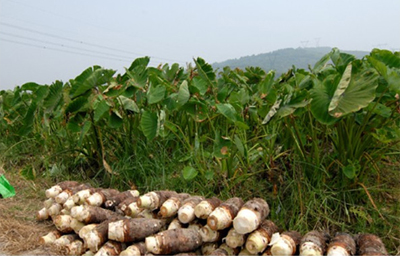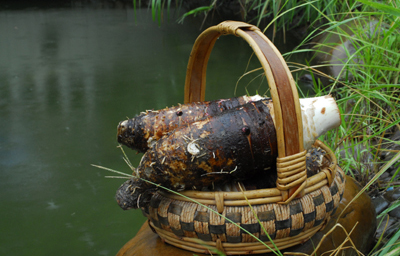Tanbu Taro was discovered since the year when the Emperor Wuzong Zhengde of Ming Dynasty ascended the throne (about A.D1506) and has the planting history of over 500 years. In Wengang village of Tanbu town, the soil is soft and thick, containing rich phosphorus and potassium. So the Tanbu taro is relatively larger and looks like olivary nucleus. It contains rich starch and thus has strong fragrant flavor. It is powdery and fragrant. And it can float over the water. With these features, Tanbu taro is known far and wide. In 1980s of 20th century, Tanbu taro has been sold to Hong Kong, Macau, Singapore, New Zealand, Canada, and other countries and regions. Today Tanbu taro has been the flagship product of Huadu and forms the specialty industry for local farmers.
Tanbu taro in Wengang village, Tanbu town of Huadu district is well known far and wide. It is said that Emperor Qianlong of Qing Dynasty has been to Tanbu Village. He went to a restaurant and asked the boss, ¡°What delicious food do you have?¡±. The boss introduced ¡°Braised port with Wengang Taro¡± to Qianlong. The dish left Qianlong very good impression. After returning Beijing, he ordered the head of Hua County to tribute Tanbu Wengang Taro. Since then, the Tanbu Wengang Taro becomes famous all over the country. To buy Wengang taro, it is recommended to get to the place of origin. The taro in Wengang village has the best flavor. The taro is soft and delicious. To validate if the taro is genuine, you may put the taro in the water. The taro which can float over the water is genuine. The taro produced in other places will sink to the bottom.
Floating taro is the genuine Tanbu Taro.
Nutritive value and development prospect of taro
Taro has high nutritive value and wide application. According to Compendium of Materia Medica, taro can be used for medical care. It can clear away the heat and toxic materials, reinforce spleen and stomach, and nourish the body. Long term consumption is good for the digestion, improving the body¡¯s immunity, preventing the cardiovascular diseases, hypertension, osteoporosis, cataract, diabetes mellitus, colorectal cancer, etc. As a kind of medical raw material and health care food, taro has very high value of development and utilization. With the increasing demand of international market on the green and harmless vegetables, the taro has great market opportunities and potential and wide development space.
Chi-Ming Tanbu Taro Seedling
Description: It is made by the taro seedling after drying. The high quality taro seedling tastes soft and waxy and has abundant fiber substance, which is helpful for the peristalsis of the large intestine. Proper amount of consumption is good for health. The common ways of cooking include steamed pork ribs with taro seedling and braised goose with taro seedling.
Materials for making steamed pork ribs with taro seedling: proper amount of pork ribs, taro seedling, shredded ginger, chopped green onion, rice wine, light soy sauce, cornstarch, salt, sugar, fruit peel and peanut oil.
Method of making steamed pork ribs with taro seedling:
Soak the taro seedling with water until it is soft and then wash away the dirt and cut into shreds. Wash the ribs and cut into blocks. Mix the cornstarch, salt, sugar, peanut oil, light soy sauce, rice and shredded ginger together and pour on the ribs. Put the shreds of taro seedling on the plate and then put ribs on the plate. Steam 15 minutes over high heat until cooked and then sprinkle with green onion. Then the cooking process is finished.



